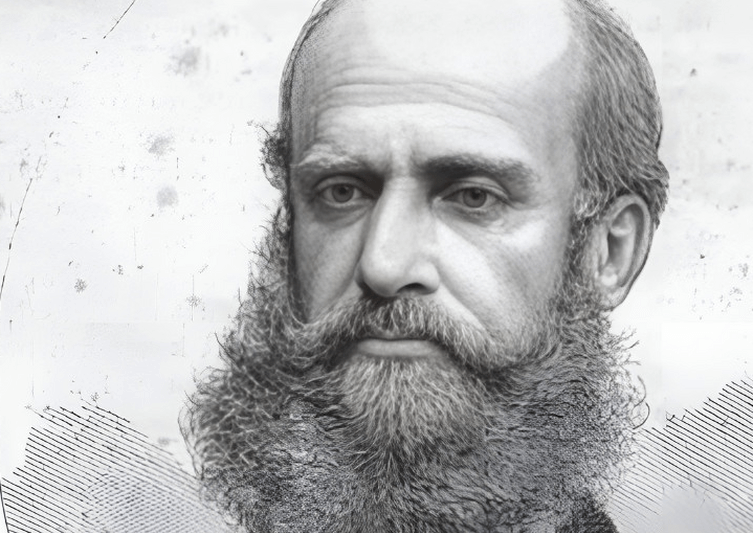The Baron Who Fell in Love with Budapest

Early Life and Background
You know how some people just seem destined for greatness? That’s exactly how Frigyes Podmaniczky’s story begins. Born on June 20, 1824, in Pest, he came from a noble family that had already done quite a bit for Budapest. But little did anyone know that young Frigyes would outshine them all! He spent his childhood in Aszód and later studied law in Késmárk – pretty standard stuff for a nobleman of his time.
The Revolutionary Years
Here’s where things get interesting! During the 1848 Revolution, Podmaniczky wasn’t content to sit on the sidelines. He jumped right into the action as a hussar captain. After the revolution failed, he was forced to serve as a common soldier in the Austrian army – talk about a fall from grace! But you know what they say about tough times making tough people…
The “Bridegroom of Budapest”
Now, this is where Podmaniczky really found his calling. He never married – and you want to know why? Because he was literally married to the city! That’s how he got his famous nickname, “The Bridegroom of Budapest.” Pretty romantic, right? He dedicated his entire life to transforming Budapest into a modern European metropolis.
His Major Achievements
First and foremost, Podmaniczky’s most significant achievement was his role as vice-president of the Public Works Council from 1873 to 1905. During these three decades, he essentially became the master planner of modern Budapest. Imagine being responsible for designing and implementing the entire layout of a major European capital – that’s exactly what he did! Under his leadership, the city developed its characteristic circular-radial street pattern, including the Grand Boulevard and the stunning Andrássy Avenue.
But that’s not all – he was also the mastermind behind some of Budapest’s most iconic infrastructure projects. You know those beautiful bridges spanning the Danube? Well, Podmaniczky oversaw the construction of three major ones: the Margaret Bridge, the Elizabeth Bridge, and what’s now known as the Liberty Bridge. He also supervised the development of the elegant embankments along the Danube, which are now such a distinctive feature of the city.
In the cultural sphere, his achievements were equally impressive. From 1875 to 1886, he served as the intendant of the National Theater, during what many consider its golden age. He had this brilliant idea to reorganize Budapest’s theaters by separating different genres, creating distinct profiles for each venue. He was also instrumental in establishing the Hungarian State Opera House – quite a feat for someone who was already juggling so many other responsibilities!
What I find particularly fascinating is how he combined his roles as a cultural leader and urban developer. For instance, he made sure that the new theater buildings were integrated into his broader vision for the city’s development. He was also quite progressive in his thinking – did you know he insisted on having seats in the ground floor area of the National Theater, making it more accessible to common citizens?
Another remarkable achievement was his contribution to Budapest’s modernization. He recognized early on that a modern capital needed proper public transportation, elegant public spaces, and wide boulevards. Here’s an interesting tidbit: he was behind the construction of Continental Europe’s first underground railway line, which ran under Andrássy Avenue. Pretty forward-thinking for the late 19th century, wouldn’t you say?
His dedication to the city was so complete that he even left his entire fortune to Budapest upon his death. This level of commitment earned him several prestigious awards during his lifetime, including the Order of Leopold First Class and the Order of the Iron Crown First Class.
What makes Podmaniczky’s achievements even more impressive is that he maintained various other important roles simultaneously. He was a member of parliament for over 40 years, president of the Liberal Party, and a corresponding member of the Hungarian Academy of Sciences. He even found time to write novels and travel accounts!
The impact of his achievements continues to be felt today. When you walk through Budapest’s grand boulevards, cross its magnificent bridges, or attend a performance at the Opera House, you’re experiencing the direct results of Podmaniczky’s vision and dedication. He truly transformed Budapest from a provincial city into a modern European capital that could rival Vienna and Paris in its grandeur and sophistication.
Best deals of Budapest
Cultural Contributions
Frigyes Podmaniczky’s cultural contributions to Budapest were nothing short of remarkable, and I’d love to tell you about this fascinating figure who earned the nickname “Budapest’s Bridegroom.” You see, his passion for cultural development was so intense that it transformed the city’s artistic landscape in ways that are still visible today.
Let’s start with his most significant cultural achievement: his role as the intendant of the National Theater from 1875 to 1886. During this golden period, Podmaniczky revolutionized Budapest’s theatrical scene. He wasn’t just an administrator – he was a visionary who understood that a great city needed great cultural institutions. Under his leadership, the National Theater experienced what many consider its most brilliant era. He had this wonderful way of managing things, combining diplomatic finesse with genuine warmth toward the theater’s employees.
What I find particularly interesting is how he approached the reorganization of Budapest’s theatrical landscape. He wasn’t afraid to make bold decisions, like separating different genres of performance. He moved folk plays and operettas to the People’s Theater, which helped create distinct cultural spaces for different types of entertainment. This might seem obvious now, but it was quite revolutionary for its time!
But perhaps his most enduring cultural legacy was his role in establishing the Hungarian State Opera House. As the vice-president of the Public Works Council, he was instrumental in its construction, but he didn’t stop there. He carefully planned the formation of the opera company and made sure everything was in place for its successful operation. Think about it – every time you visit the magnificent Opera House today, you’re experiencing part of Podmaniczky’s vision.
He was also quite the writer himself, though he was modest about his literary achievements. He wrote novels like “The Blue-Spectacled Woman” and “A Single Teardrop,” as well as travel writings and memoirs. While these might not be considered masterpieces today, they provide valuable insights into the cultural life of 19th-century Budapest.
What really sets Podmaniczky apart was his holistic approach to cultural development. He understood that culture wasn’t just about grand buildings and institutions – it was about creating spaces where people could gather, socialize, and enjoy the arts. The elegant boulevards and promenades he helped create weren’t just infrastructure projects; they were vital cultural spaces that transformed how people experienced their city.
His influence extended to the academic world as well. As a member of the Hungarian Academy of Sciences (elected in 1859), he helped bridge the gap between cultural and academic life in Budapest. He had this remarkable ability to see how different aspects of urban life – architecture, art, education, and entertainment – could work together to create a truly vibrant cultural atmosphere.
I think what’s most touching about Podmaniczky’s cultural contributions is how personal they were to him. He never married, dedicating his life instead to making Budapest a cultural capital that could rival Vienna or Paris. He was often seen walking the streets in his distinctive checkered coat, personally overseeing the cultural transformation of his beloved city.
His legacy lives on in every corner of Budapest’s cultural life – from the grand institutions he helped establish to the very way the city’s cultural spaces are organized. It’s a testament to his vision that many of the cultural institutions and spaces he helped create are still central to Budapest’s cultural life today.
Personal Style and Character
Frigyes Podmaniczky was quite a character – the kind of person who left an indelible mark not just through his actions, but through his distinctive personality and style. Known affectionately as the “Bridegroom of Budapest,” he was instantly recognizable on the streets of the city he loved so dearly, often sporting his signature checkered overcoat that earned him the nickname “the checkered baron” or “pepita baron.”
What made Podmaniczky truly special was his unique combination of aristocratic bearing and down-to-earth approachability. Despite his noble birth, he carried himself with a warmth and accessibility that endeared him to people from all walks of life. His manners were impeccable, yet never stiff or formal, and he was known for treating everyone – from high-ranking officials to common laborers – with the same level of respect and courtesy.
His personal character was marked by an unwavering moral compass and an almost legendary dedication to his beloved Budapest. Unlike many of his contemporaries who split their time between various estates and the capital, Podmaniczky was famous for rarely leaving the city, claiming that there was simply no better place to be – even for a vacation! This dedication wasn’t just talk; he literally devoted his entire life and fortune to improving the city.
One of his most endearing traits was his passion for the arts and culture. As the intendant of the National Theater and later the Opera House, he showed not just administrative skill but a genuine love for the arts that went far beyond mere duty. He was also an accomplished writer himself, though he approached this pursuit with characteristic modesty.
Interestingly, Podmaniczky never married, leading to the romantic notion that Budapest itself was his one true love. This personal choice became part of his legend, reinforcing his image as a man wholly devoted to his city’s development and welfare. His lifestyle was modest despite his noble status, and he was known to invest his personal resources in city development projects rather than living an extravagant lifestyle.
What’s particularly fascinating about his character was his ability to maintain his enthusiasm and optimism even in the face of criticism. Toward the end of his career, when some began to question his grand visions for the city, he remained steadfast in his beliefs and continued to work tirelessly for Budapest’s development. This resilience, combined with his gentle but determined nature, made him a truly remarkable figure in Hungarian history.
In many ways, Podmaniczky represented the perfect blend of old-world nobility and modern civic-mindedness. His elegant appearance, marked by his distinctive clothing choices, his cultured manner, and his progressive thinking about urban development created a unique personality that became synonymous with Budapest’s golden age of development. Even today, his character serves as an example of how personal style and public service can combine to create a lasting legacy.
Fun Facts and Anecdotes
You know, Baron Frigyes Podmaniczky was quite a character in 19th-century Budapest, and there are some fascinating stories about him that really bring his personality to life. People used to call him the “Bridegroom of Budapest” because he was so devoted to the city that he never married – Budapest was literally his one true love! How’s that for dedication?
Here’s a fun tidbit: he was known by several nicknames among the locals. They called him the “Checkered Baron” or “Pepita Baron” because he always wore this distinctive checkered overcoat that made him instantly recognizable on the streets of Budapest. He must have been quite a sight walking around in his signature outfit!
Speaking of interesting facts, did you know that Podmaniczky was absolutely obsessed with greyhounds? He wasn’t just a casual fan – he actually owned a breeding facility and was a regular at greyhound races. It’s these little personal details that make him seem so much more human, don’t you think?
One of the most remarkable things about him was how he spent his fortune. Instead of living a life of luxury like many nobles of his time, he invested his money in developing Budapest. And get this – when he died, he left his entire fortune to the city he loved so much. Talk about putting your money where your heart is!
What’s particularly endearing about Podmaniczky is how he managed to be both an aristocrat and a man of the people. He was known for his impeccable manners and elegance, but also for his warm personality and accessibility. The locals loved him so much they even called him “the best-hearted Hungarian gentleman” – quite a compliment in those days!
And here’s a bit of trivia that might surprise you: he was instrumental in building the first underground railway system on the European continent! Yes, that’s right – Budapest’s famous underground line was partly his brainchild. He really was thinking ahead of his time.
Perhaps one of the most touching aspects of his legacy is how he spent his final years. After a lifetime of public service, he retired at 81 and lived quietly in Budapest’s Erzsébetváros district, still surrounded by the city he had helped to build and shape. Even today, every June 20th, the Budapest City Protection Association lays a wreath at his birthplace, keeping his memory alive.
These stories and anecdotes really show why Podmaniczky was such a beloved figure in Budapest’s history. He wasn’t just another nobleman or politician – he was a true character who left an indelible mark on the city through both his work and his personality. It’s no wonder that even today, more than a century after his death, people still talk about the “Bridegroom of Budapest” with such fondness and respect.
Legacy and Final Years
In his twilight years, Baron Frigyes Podmaniczky’s passion for Budapest never wavered, though his grand visions for the city began to face increasing criticism. As he approached his 81st year in 1905, he gradually withdrew from public life, spending his final days in the district of Erzsébetváros, where he had overseen so much development during his career.
The “Bridegroom of Budapest,” as he was affectionately known, left an indelible mark on the city he loved so dearly. His legacy can still be seen today in the grand boulevards, elegant public squares, and architectural masterpieces that define modern Budapest. Perhaps most notably, he was instrumental in the construction of Andrássy Avenue and the Grand Boulevard (Nagykörút), as well as overseeing the development of the continent’s first underground railway system.
Despite some criticism in his later years, Podmaniczky’s dedication to Budapest remained unwavering until his death in 1907. In a final gesture of his devotion to the city, he bequeathed his entire fortune to Budapest, a testament to his lifelong commitment to its development. He was laid to rest in the Lutheran church in Aszód, where his childhood years had been spent.
Podmaniczky’s impact on Budapest was so significant that it’s somewhat ironic that his name isn’t more widely recognized today. Though there is a square named after him in Budapest’s 5th district, where a statue created by Pál Kő was erected in 1991, many feel this doesn’t adequately reflect his enormous contribution to the city. The Budapest City Protection Association honors his memory annually by laying a wreath at his birthplace on June 20th, but some argue that his legacy deserves greater recognition.
His final years were marked by the satisfaction of seeing his life’s work come to fruition – Budapest had transformed into a modern metropolitan city that could rival the likes of Paris and Vienna. Though he never married, preferring to dedicate his life entirely to the city’s development, he left behind a legacy that continues to shape Budapest’s identity today. His vision, determination, and unwavering dedication to public service set a standard that modern city planners and public servants still aspire to match.
In many ways, Podmaniczky’s story represents the golden age of Budapest’s development, when vision, dedication, and public service combined to create something truly remarkable. His passing marked the end of an era, but his influence continues to be felt in the streets, buildings, and cultural institutions of modern Budapest.
Remembering Podmaniczky Today
It’s kind of ironic that despite everything he did for Budapest, many people today barely know who he was. There’s a square named after him in Budapest’s 5th district, and a statue by Pál Kő was erected there in 1991. The Budapest City Protection Association commemorates him annually on his birthday, June 20th, but given his contributions, don’t you think he deserves even more recognition?
Podmaniczky’s story shows us how one person’s dedication can transform an entire city. His vision helped turn Budapest into the beautiful capital we know today. Pretty impressive for someone they called “Budapest’s greatest fool,” don’t you think?
Image source: Budapest City Defender Association

















